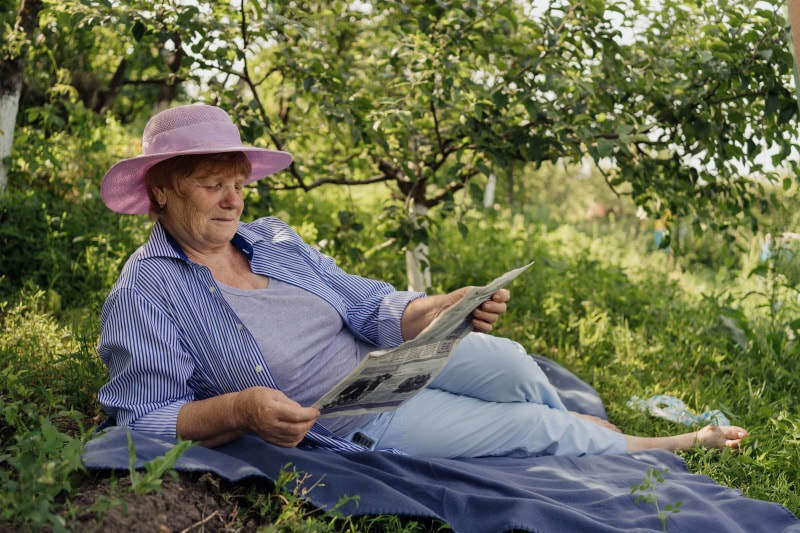|
We had a little fun with this! Here is a comparison of the top five favorite entertaining/cocktail party type appetizers in the 1950-60s compared to today:
1950-60s:
What are some of your party favorites?
0 Comments
The recreational activities of senior citizens have changed drastically over the years. What was once popular in the mid-1950s is now antiquated and often forgotten, while new activities have become the norm.
Here is a comparison of the top five favorite recreational activities of senior citizens then and now. Then: 1. Gardening: Gardening was a popular activity among seniors in the mid-1950s. Many seniors kept flower and vegetable gardens, often growing their own food. 2. Fishing: Fishing was a favorite pastime for many seniors, who would usually gather at local lakes and rivers in the summer months. 3. Playing cards: Playing cards was a popular social activity among seniors in the 1950s. They would often gather in groups and play card games like bridge and solitaire. 4. Reading: Reading was another popular pastime among seniors in the 1950s. Many seniors would gather in public libraries to read newspapers and books, or even attend book clubs. 5. Playing bingo: Bingo was a popular game among seniors in the mid-1950s. Many seniors would gather in community centers to play bingo, and it became a social activity for many. Now: 1. Playing video games: Video games have become an increasingly popular activity among seniors. Many seniors now enjoy playing video games on their own or with friends. 2. Going to the movies: Going to the movies is now a favorite activity for many seniors. Many seniors enjoy going to the theater to watch new films or attending movie nights with friends. 3. Shopping: Shopping has become a popular activity for many seniors, who enjoy going to the mall or browsing online stores. 4. Walking: Walking is now a popular activity among seniors, who enjoy taking leisurely strolls in nearby parks or going for brisk walks on the beach. 5. Socializing: Socializing has become a popular activity for many seniors, who often gather in coffee shops or restaurants to catch up with friends. As the years have passed, the recreational activities of senior citizens have changed drastically. What was popular in the mid-1950s is now often forgotten, while new activities have become the norm. Whether it’s playing video games or going to the movies, there are many activities for seniors to enjoy. Charlene Frazier Community Coordinator 785-822-1300 residentservices.600@gmail.com In an age of social distancing, it can be difficult for senior citizens to stay connected with their grandchildren. With stay-at-home orders in effect and visitors limited, seniors must find innovative ways to interact and bond with their grandchildren.
One of the best ways for seniors to connect with their grandchildren is through video chat. With technology like FaceTime, Skype, or Google Hangouts, seniors can have face-to-face conversations with their grandchildren from the safety of their own homes. This allows seniors to maintain their relationships with their grandchildren and share special moments with them no matter the distance. Another way for seniors to stay connected with their grandchildren is through social media. Seniors can follow their grandchildren’s activities and updates on platforms like Instagram and Twitter. They can also post messages of encouragement, share photos, and send virtual hugs. Seniors can also use technology to interact with their grandchildren in a fun and creative way. They can play online games together, watch movies or TV shows, or even take virtual tours of museums. These activities can be both entertaining and educational, and they’re a great way to bond with their grandchildren. There are many other ways for seniors to connect with their grandchildren remotely. Seniors can write letters or postcards to their grandchildren, exchange emails, or send care packages. They can also create a photo album or scrapbook together, or start a blog to share stories and memories. No matter how seniors choose to interact with their grandchildren, it’s important to remember that the connection is what matters most. Even with the challenges of social distancing, seniors can still find ways to stay connected and have meaningful conversations with their grandchildren. In recent years, senior citizens have begun to embrace the idea of playing cards and board games as a way to stay active and keep their minds sharp. With the population of seniors continuing to increase, it’s important to provide an engaging and entertaining activity that will help keep them engaged and alert.
Playing cards and board games can provide a stimulating mental exercise that is both fun and beneficial. Playing card games, such as bridge and poker, can be a great way for seniors to exercise their minds and keep their skills sharp. Card games require players to make decisions quickly and work through strategies to maximize their chances of success. By playing card games, seniors will be able to increase their cognitive abilities, such as problem solving and memory recall. Board games are another great way for seniors to stay active and keep their minds sharp. Board games, such as chess and checkers, require players to think ahead and plan their moves in order to be successful. This type of mental exercise helps seniors keep their minds sharp and encourages them to think critically. In addition to being a great way to stay active and keep their minds sharp, playing card games and board games can also be a great way for seniors to socialize and interact with others. Board games can be a great way to bring friends and family together for a night of fun and laughter. In addition, many senior centers and retirement homes offer weekly card game and board game nights, which can be a great way for seniors to connect with others. Overall, playing cards and board games can provide seniors with a fun and stimulating activity that can help keep their minds sharp. By playing cards and board games, seniors can stay active and engaged while also enjoying the company of others. So, if you know a senior citizen who’s looking for a fun and challenging way to stay active and keep their minds sharp, suggest that they give card games or board games a try. Charlene Frazier Community Coordinator 785-822-1300 residentservices.600@gmail.com Quick! How many song titles can you think of with "Spring" in the title or lyrics?
Did you name the popular "Spring is Busting Out All Over"? This fun song from the musical Carousel celebrates the bursting forth of spring "all over the meadow and the hill." Another great song from this musical is "You'll Never Walk Alone." How about Simon and Garfunkel's "April, Come She Will" with its lovely lyrics, contrasting the gentleness of springtime ("resting in my arms again") to the melancholy of autumn ("a love once old has now grown cold.") "It Might as Well be Spring" came from the musical State Fair by Rodgers and Hammerstein (even though state fairs were traditionally held in the autumn), but it's been recorded by such diverse singers as Johnny Mathis, Dick Haymes, Sammy Kaye, Sarah Vaughan, Frank Sinatra and Andy Williams. The classic "Some Other Spring" by Billie Holiday, is a sad tribute to lost love, with the singer hoping for another chance for her heart "to awake" and find love. Elvis Presley's "Spring Fever" was featured in the movie Girl Happy, in which a rock and roll singer is hired to keep his eye on the daughter of a mobster during her Spring Break. Did he keep her out of trouble or did he woo her with lyrics like, "Spring fever, my heart's beating fast; get up, get out, Spring is everywhere"? Which one of these Spring songs will you be humming this March and April? Charlene Frazier Community Coordinator 785-822-1300 residentservices.600@gmail.com The March calendar is often colored green, with shamrock and elf decorations. After German, Irish is the heritage most claimed by Americans. More Americans have Irish ancestors than there are people in Ireland, which might explain why St. Patrick's Day is such a popular holiday in the United States.
Irish immigrants to America brought some of their festivals and customs with them, including honoring St. Patrick, a British man who reportedly converted pagan Irish people to Christianity, after escaping slavery. In America, the holiday became not religious, but secular, centered around the color green and beer! How old is the American celebration? Boston held its first St. Patrick's Day parade in 1737, before the American Revolution! St. Patrick's color traditionally was blue, but the leaf of the shamrock gave the holiday its green tint Why do we get pinched if we don't wear green? Green was the color for Irish solidarity, and anyone not wearing it to honor St. Patrick could be slapped or pinched as a punishment. Other traditions say that wearing green makes a person invisible to the little Irish tricksters, the leprechauns, who might sneak up and pinch people at any given time. What's the Luck of the Irish? In early America, Irish were not very lucky. Unlike immigrants from Great Britain or the Germanic countries, who were respected as smart hard-workers, Irish were unfairly said to be lazy and unintelligent. However, during the West Coast gold rush years, some of the most successful gold and silver mines were discovered by people of Irish descent. The phrase was not entirely complimentary, as it implied that it took luck, not intelligence, for an Irish person to find good fortune. Why beer on St. Patrick's Day? St. Patrick's Day, on the Christian calendar, generally falls during the season of Lent, when fasting and sacrifice are encouraged. But the bans on meat and indulgent foods were lifted for the one day, which caused it to eventually be associated with a party spirit… and party spirits. Whether you're Irish or not, St. Patrick's Day has become a popular American holiday, so put on something green, display a shamrock, or have a sip of beer to celebrate. Charlene Frazier Community Coordinator 785-822-1300 residentservices.600@gmail.com Recently, a woman in her fifties asked her friend, a woman in her seventies, what she wished she would have done differently earlier in her life. "If you could talk to your younger self, what advice would you give her?"
1. Make more and deeper friendships. Skip some of those social groups or committees that really just squander time, in order to strengthen the relationships that support and uplift you. Take time to affirm the good friends you have and seek out a few more who share your interests and outlooks. 2. Take care of skin, eyes and teeth! While we watch our weight or make time for gym workouts, we might forget the little things that make a big difference in our overall health. Sunscreen and sunglasses, daily brushing and flossing, and regular visits to the dentist and eye doctor will pay off in later years. 3. Spend more time in nature. People often regret time in the office or workplace, but many seniors agree that they would have enjoyed more vacations, more walks outdoors and more time just enjoying fresh air and natural surroundings. We can't always afford a cruise or amusement park, but we can take a walk in the park or just survey the backyard. 4. Enjoy the moment. Looking backwards, few people think how slowly life went. Many will express the wish that they had enjoyed their childhood or health or family members or educational opportunities more. Each day we can decide to find something to enjoy, so that we needn't look back with regret when another year has passed. Do the answers surprise you? Can you think of any other advice you would give your younger self? Feel free to pass it along to a younger friend. Charlene Frazier Community Coordinator, Residence 600 600 E. Elm, Salina KS 67401 785-822-1300 residentservices.600@gmail.com Was there a real St. Valentine? Legends say he might have been a Roman priest in the third century, who performed secret marriages against the law. Unfortunately, those who have studied the matter say this tale is possibly just colorful imagination. St. Valentine's day wasn't associated with romantic love until it was popularized by Chaucer in the late Middle Ages.
How about Punxsutawney Phil? That's the Pennsylvania groundhog which is said to predict the weather. This particular rodent (who probably has been a series of his species) has been consulted since 1886, but even before that, both Germanic and Celtic legends include stories of a hibernating animal's shadow foretelling of the length of winter. Sadly, Phil has only been right 39% of the time. Was George Washington's birthday actually February 22, as we observed it in our school days? Yes and no. He was actually born under the old Julian Calendar on February 11, 1731. But when England changed to the newer Gregorian calendar, people were instructed to add eleven days to their birthdates. Furthermore, if they were born between January 1 and March 25, like Washington, they were to add an additional year! Our first President's birthday is now celebrated with others' on Presidents Day, which is Feb. 20 this year. Is the Mardi Gras' carnival just a big party? Not originally. The word "carnival" comes from the Latin words for "taking away meat," which referred to the fasting done by Christians as the season of Lent began the day after Mardi Gras (or "Fat Tuesday"). Modern-day partying is done in anticipation of the weeks of reflection and being deprived. True, partly true or just plain made-up, the myths of February provide us with some interesting and entertaining holidays. Celebrate! Charlene Frazier Community Coordinator, Residence 600 600 E. Elm, Salina KS 67401 785-822-1300 residentservices.600@gmail.com Maybe you were one of those children who had to be called and called (and called!) to come indoors for a meal or bedtime. Or maybe you were the kind who wanted only to curl up in a corner with a book until your parent said, "Go out and get some sunshine!" Either way, we now know the benefit of "playing outdoors" for both children and adults.
The daily routine of many seniors is… routine, and most of it takes place inside. Getting outside is one way to break monotony and explore new things, even if it's only for a brief time. Listening to moving water, seeing green grass or watching the squirrels eat are ways to feel more alive. The added physical and mental exercise truly helps ward off cognitive decline and dementia. Being out in the fresh air boosts Vitamin D. Exposure to sunlight helps the process of healing. Being outdoors for even a short period can improve sleep patterns. Just seeing something new can be a distraction from the aches and pains felt while sitting at home. Exposure to the breeze and nature helps the entire nervous system. Motor skills and balance improve with increased activity, as does the energy level. Taking a little walk can reduce stress and anxiety. Walking with a friend will provide even more stimulation, and while outside, someone new might appear: a neighbor, a friendly pet-walker or a friendly pet! Concentrating on something farther away than the wall, like a neighbor's home, cars passing or a rustling tree can improve eye focus. Seeing changing vistas or different activities will provide something new to think about or to research later. What kind of bird was that? What are they building on Pear Street? How quickly the seasons are passing! Enjoying the great outdoors can be a wonderful reminder than we are a part of something much bigger than ourselves. So, put on a hat if it's hot, or a coat if it's chilly, and "Go out and get some sunshine!" Charlene Frazier Community Coordinator, Residence 600 600 E. Elm, Salina KS 67401 785-822-1300 residentservices.600@gmail.com One in three seniors will fall outdoors at least once this year. While we tend to think of falls as happening in the home, outdoor falls are more common than indoor falls. More than half of all adult falls happen outside.
Since we don't want to become hermits, what can we do to keep ourselves and others safe when we leave our homes? There are many ways to take a little journey outdoors without making a trip into a trip! Improve the outdoor space.
Improve ourselves.
Improve the experience.
And if we do take a fall:
Charlene Frazier Community Coordinator, Residence 600 600 E. Elm, Salina KS 67401 785-822-1300 residentservices.600@gmail.com |
Archives
March 2024
Categories |
|
Residence 600
600 E Elm St Salina, KS 67401 (785) 822-1300 M-F: 9a-4p, Sat-Sun: Closed residentservices.600@gmail.com |
|
Powered by Janzen Marketing, LLC.
Luxury Senior Living
Luxury Senior Living











 RSS Feed
RSS Feed
